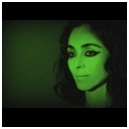Shirin Neshat
Shirin Neshat
Bio:
SHIRIN NESHAT
Iranian-born visual artist Shirin Neshat is known for her hauntingly beautiful explorations of Islam and gender relations. Over the past 15 years, Neshat has created provocative expressions drawn on her personal experiences in exile, and on the widening political and ideological rift between the West and the Middle East. Her potent statements in still and moving images evoke the struggles that define her.
Born in Qazvin, one of the most religious cities in Iran, Shirin Neshat is perhaps the most famous contemporary artist to emerge from that country. Neshat left Iran just before the Islamic revolution (1979) and the fall of the Shah. Her consequent visits to Iran after the revolution led to the creation of a body of work which launched Neshat’s artistic career, however, since 1996 she has not been able to return to her country due to the controversial nature of her art. After receiving her degree in art from the University of California at Berkeley, Neshat moved to New York, where she continues to live and feel the pull and push of her roots. She examines her homeland from a distance, as well as in closer perspective on her travels across the Middle East.
On today’s complicated global stage, Neshat’s voice is unmistakably relevant. She first gained prominence with Women of Allah (1993-97), a series of photographs depicting women in veils carrying guns with their skin covered in Islamic poetry. These arresting images reflected Neshat’s sense of how the revolution had changed the Iran that she knew, especially the lives of women seeking freedom, rebelling in martyrdom and militancy.
By 1998, when Neshat began experimenting with film and video installations, she met Iranian artist/filmmaker, Shoja Azari. They began a collaboration which has led to numerous important video pieces such as the trilogy—Turbulent (1998), Rapture (1999), and Fervor (2000)—about gender roles in the restrictive Islamic society. In the first two cinematic statements, she immersed the viewer literally in the middle of the works, which were projected on two screens, each occupied by actors of one sex. The men and women are physically separated here in art, as in real life. In Turbulent, Azari performed the role of male singer while Sussan Deyhim, was the female singer. Here Neshat explored singing as a metaphor for freedom, inspired by an Iranian ban on women singing. In Rapture, she continued her theme with a story about women moving across the desert, and how a few eventually break free to leave on a small boat. Fervor expressed the passionate yearning of a couple who can only make contact with their eyes, closing the trilogy with an emphasis on the common ground shared between the sexes.
On a more personal note, Neshat explored her own displacement in Soliloquy (1999). Again using duo projections, she places an image of herself in the Middle East on one screen, and an image of herself in the West on another, visually revealing the split between the two very different cultures that are both a part of her life.



